The Essential Role of Kiteboard Trainers in Watersports

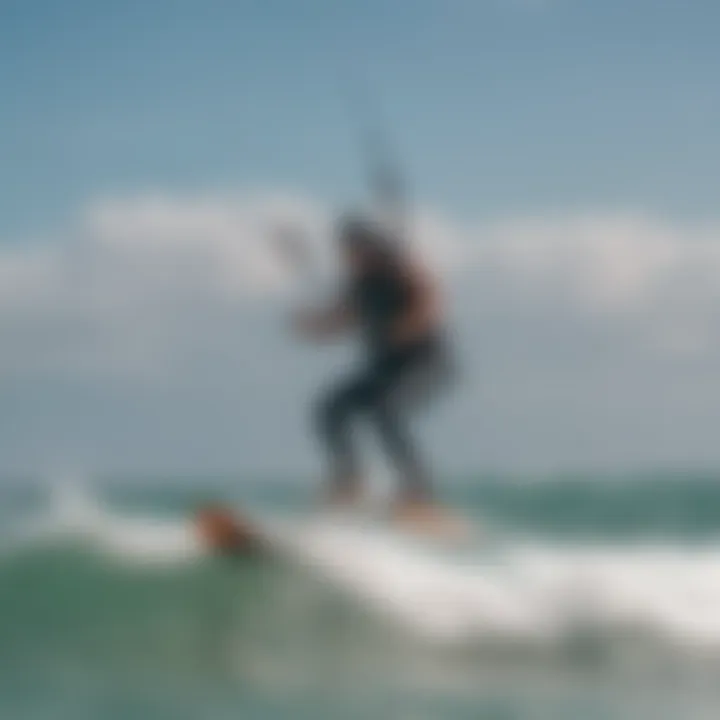
Intro
Kiteboarding is not just about riding the waves; it’s a blend of skill, confidence, and safety on the water. For those eager to master this exhilarating sport, the role of the kiteboard trainer cannot be overstated. Trainers serve as navigators through the tumultuous sea of techniques, safety protocols, and ever-evolving trends in kiteboarding. They are not merely instructors; they are mentors, guides, and role models for aspiring kiteboarders.
As the kites soar and the boards glide, trainers instill not just the mechanics of kiteboarding, but also a deeper appreciation for the sport. The kiteboarding community thrives on shared knowledge, safety, and camaraderie, all facilitated by these dedicated trainers. Their influence significantly shapes the learning path for newcomers, ensuring that passion is ignited and fostered.
In the subsequent sections, we will dive into the essential techniques trainers employ, the critical safety measures they impart, and how they engage with the kiteboarding community.
Techniques and Skills
Exploring the intricacies of kiteboarding begins with understanding the fundamental techniques necessary for beginners and the advanced skills that seasoned athletes might aim to refine. Each step of learning lays the groundwork for future mastery.
Fundamental Techniques for Beginners
For newcomers, grasping the basics can feel akin to trying to hold water in your hands. Success hinges on a few core techniques:
- Kite Control: Learning how to control the kite is paramount. This includes understanding how to launch, land, and fly the kite efficiently. Beginners should practice figure-eights in the sky—a useful drill to build confidence.
- Body Positioning: Proper body position is key while riding. This involves leaning back, keeping a low center of gravity, and maintaining balance on the board. It's more about attitude than skills at first; confidence leads to better performance.
- Water Start: Once kite control is mastered, the water start is the next hurdle. Timing the pull of the kite and the board’s momentum requires practice but will lead to that exhilarating first ride.
Advanced Skills for Experienced Athletes
As one progresses, the next set of skills features more complexity and finesse:
- Jumping Techniques: Mastering jumps brings joy and freedom. The approach involves understanding wind power and timing, both critical for a graceful lift-off. Trainers encourage progression from small hops to larger jumps.
- Tricks and Stunts: Once comfortable in the air, athletes often explore tricks. This includes spins, rotations, and even flips. Professional trainers work closely with advanced students to ensure safe execution while offering invaluable feedback on technique.
- Riding in Different Conditions: Experienced kiteboarders should adapt to varying weather and water conditions. Knowing how to adjust techniques based on wind strength and water currents is a hallmark of an adept athlete.
Safety and Gear
Safety cannot be overstated in kiteboarding, where thrill and potential peril dance hand in hand. A kiteboard trainer prioritizes safety to create a secure learning environment for all participants.
Essential Safety Measures in Watersports
- Pre-Flight Check: Before any kite session, a thorough check of gear is mandatory. This includes inspecting the kite, harness, lines, and board for any wear and tear.
- Understanding Local Conditions: Trainers emphasize the importance of knowing local weather forecasts and tides. Awareness of surrounding conditions can save lives.
- Safety Protocols During Training: Clear communication between trainer and students establishes a safe learning area. Trainers often implement "buddy systems" where students pair up, keeping an eye on one another.
Gear Reviews and Recommendations
The right equipment is vital, and trainers often provide insights on gear selection. It pays to consider:
- Kite Type: Trailing edge designs change the experience—hybrid kites serve well for learners while advanced riders often prefer specific models suited for tricks or waves.
- Board Styles: Size and type matter; a larger board provides stability for beginners, whereas advanced riders may opt for a smaller board enhancing performance.
- Harnesses: Comfort is crucial. A well-fitted harness prevents injury and enhances performance. Trainers often recommend trying different types to find the best fit.
“Safety first, fun second, and skill development as a constant—this is the mantra.”
In summary, the journey of kiteboarding training is intricate and rewarding. The role of the kiteboard trainer is not just about teaching but fostering a safe community where passion for the sport can flourish. Together, they shape the kiteboarding landscape, ensuring that participants transform into adept riders who respect the sport, its challenges, and its community.
Intro to Kiteboarding
Kiteboarding, a thrilling blend of surfing, wind sports, and aerial acrobatics, often draws in adventure enthusiasts and curious learners alike. It stands as a way to connect with nature, offering both serene escapism and adrenaline-pumping excitement. For anyone looking to embrace this sport, it's crucial to understand the fundamentals that make kiteboarding not just a sport, but a community-driven lifestyle.
Participating in kiteboarding opens the door to a world of experiences. From navigating diverse water conditions to learning the art of harnessing wind power, each facet of the sport carries weight in its significance. Furthermore, engaging in kiteboarding can bring health benefits. The physical demands involve core strengthening, enhancing balance, and developing agility, which contribute positively to overall fitness.
Overview of the Sport
Kiteboarding involves riding a board while being pulled by a parachute-like kite, controlled by a series of lines and a harness. At first glance, it might seem intimidating, but breaking it down reveals a methodical and rewarding process. The essence of the sport lies in its combination of skills, such as maneuvering the board, managing the kite's flight, and understanding the wind's effects.
The gear involved typically includes a kite, a control bar, lines, and a board. Each component is designed for specific uses, whether it's for beginners learning the ropes or advanced riders pushing their limits. With the proper training and support, novices can progress quickly, tackling new tricks and techniques.
The kiteboarding culture itself promotes camaraderie, as enthusiasts share tips and experiences on the beach, creating bonds that foster learning and safety. The sport is not just about individual skill; it incorporates community, mentorship, and a sense of belonging.
Historical Development
The roots of kiteboarding stretch back to ancient times when explorers harnessed the wind for various transportation needs. However, the modern iteration of the sport emerged in the late 20th century. With the introduction of inflatable kites by pioneers like Peter Lynn, the boundaries of what was possible began to expand. Early adopters faced challenges, navigating through trial and error, paving the way for innovations in both equipment and techniques.
By the turn of the century, kiteboarding had transformed from niche activity to a popular sport, with competitions and events sprouting around the globe. In places like Hawaii and the Caribbean, kiteboarding noticeably developed its own identity, attracting both professional athletes and casual adventurers.
Through changes in design, safety mechanisms were also introduced, ensuring that newcomers could engage in the sport with a lower risk of injury. The evolution of kiteboarding encapsulates not just technological advancements but also the spirit of adventure that defines it today. As it grows, the need for knowledgeable trainers has become paramount, directly shaping the learning journey of every aspiring kiteboarder.
Defining the Kiteboard Trainer Role
In the world of kiteboarding, the kiteboard trainer plays a pivotal role, acting as a bridge between novices eager to learn and the exhilarating experience of mastering this thrilling water sport. This section sheds light on the nuances of a trainer’s job, outlining the core responsibilities and essential qualities that define excellence in this field.
Responsibilities and Expectations
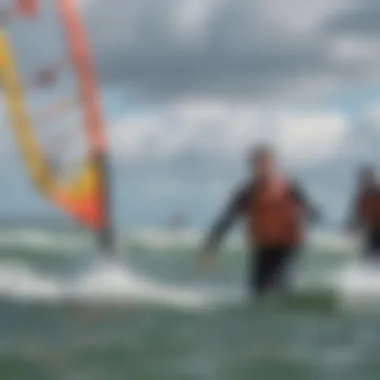
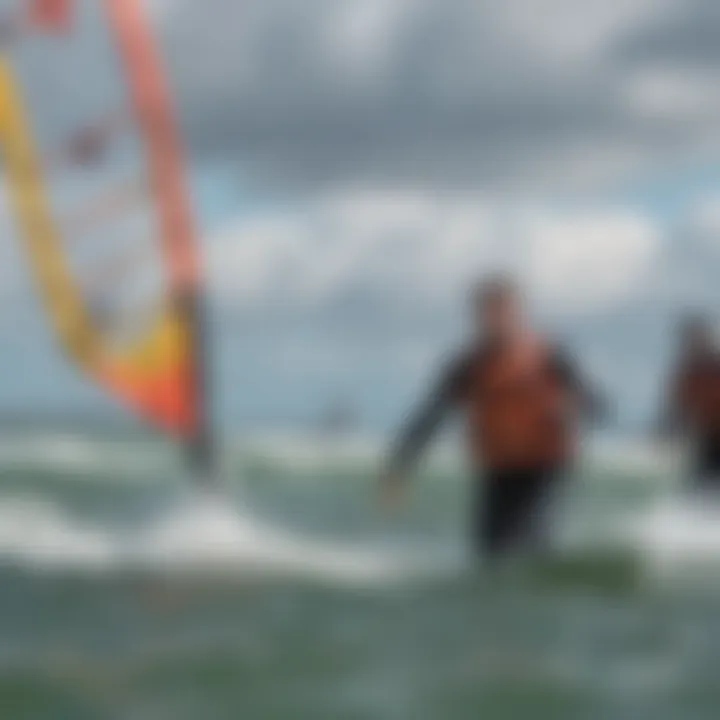
A kiteboard trainer is entrusted with the significant task of ensuring that students not only learn the technical skills needed to operate a kite effectively but also develop a deep understanding of safety practices and environmental awareness. Their responsibilities are multifaceted, comprising:
- Skill Development: Trainers guide beginners through various stages of learning, from understanding kite control to executing more complex maneuvers. They create structured lessons that progressively build a learner’s confidence and ability.
- Safety Instruction: One of the critical expectations from a trainer is to prioritize safety. They should adequately communicate weather conditions, identify suitable locations for lessons, and ensure that students are equipped with the necessary safety gear before hitting the water.
- Equipment Familiarity: Trainers must be well-versed in various kiteboarding equipment, including different types of kites and boards. They guide learners on selecting the right gear based on skill level, body type, and wind conditions.
- Motivational Support: As they train, many learners may hit a wall or lose confidence. A great trainer knows how to motivate and encourage students, helping them push through challenging moments.
"A good trainer isn’t just about teaching; they’re about inspiring passion and perseverance."
The expectation is not merely to teach but also to foster a supportive atmosphere where students feel encouraged to ask questions and express doubts, cultivating a love for the sport that lasts a lifetime.
Essential Qualities of a Trainer
As much as knowledge and practical skills are vital, the effectiveness of a kiteboard trainer hinges on their personal qualities. The following traits are paramount:
- Patience: Kiteboarding can be a daunting sport for newcomers. A patient trainer understands the learning curve involved and makes every effort to ensure each learner progresses at their own pace.
- Communication Skills: Clear communication can make or break a lesson. Trainers need to articulate complex concepts in simple terms, ensuring that students leave with a thorough understanding of the material covered.
- Adaptability: The kiteboarding environment is ever-changing, influenced by unpredictable weather conditions and diverse student needs. A successful trainer must adapt their lesson plans on the fly, addressing immediate challenges as they arise.
- Passion for the Sport: A trainer's enthusiasm for kiteboarding is infectious. When a trainer genuinely enjoys what they do, it reflects in their teaching, inspiring students to connect emotionally with the sport.
- Empathy: Understanding a beginner’s worries and fears is crucial. An empathetic trainer can create a safe learning environment where students feel at ease, fostering a sense of community and shared learning.
In sum, defining the kiteboard trainer role goes beyond simply teaching skills; it involves shaping the future of kiteboarding enthusiasts through understanding, support, and a commitment to safety. Those who take on this role bear the responsibility of nurturing the next generation of kiteboarders and instilling in them a love for the sport.
Technical Skills for Trainers
The role of a kiteboard trainer is not just about sharing a passion for the sport; it encompasses a set of technical skills that are vital for ensuring safe and effective learning experiences. These skills empower trainers to create a structured environment where students can grasp the nuances of kiteboarding, from the ground up. Without a solid foundation in these technical aspects, trainers risk not only their own safety but also that of their students, which is why these skills are central to a trainer's expertise.
Kite Control Basics
Kite control serves as the bedrock for successful kiteboarding. Effective trainers need to convey the intricate relationship between the kite and the rider. A well-controlled kite can mean the difference between a smooth ride and an accident waiting to happen.
- Understanding Power Zones: Trainers teach students how to identify power zones—areas where the kite generates more lift and force.
- Launching and Landing Techniques: Proper launching and landing are crucial. A good trainer demonstrates how to manage the kite during these phases, focusing on harnessing wind shifts and minimizing risks.
- Steering and Trimming: Ensuring that students grasp how to steer the kite effectively and trim the lines is essential. Trainers should not only show but explain the physics behind these concepts to create a comprehensive understanding.
Students who master these basics will find themselves better positioned to progress to more advanced maneuvers.
Safety Measures and Protocols
Safety is paramount in kiteboarding, and trainers play a significant role in inculcating a culture of safety among their students. This involves both knowledge and practical application of various safety measures.
"An ounce of prevention is worth a pound of cure."
- Pre-Flight Checks: Trainers should instill the habit of pre-flight checks. This includes inspecting equipment, checking knots, and ensuring the kite is in good condition. Little oversights can lead to serious consequences later.
- Understanding Weather Conditions: Knowing how weather affects kiteboarding is a non-negotiable trait. Trainers should educate attendees about the responsibilities of assessing wind conditions prior to launching the kite. It's about reading the elements.
- Emergency Procedures: Trainers must also teach students how to respond in emergencies. This includes implementing quick release systems and knowing how to swim with the board if they end up in the water unexpectedly. By role-playing potential emergency scenarios, trainers help students build confidence in their responses.
Advanced Techniques in Kiteboarding
Once a solid grasp of the basics and safety protocols is established, trainers can introduce students to advanced kiteboarding techniques. This step is where the excitement begins to peak.
- Jumping Techniques: Trainers can show how to execute jumps, discussing the importance of pop, timing, and kite control.
- Tricks and Freestyle Maneuvers: It's also about pushing limits. Advanced techniques in freestyle require a mix of power, skill, and aerial awareness. Trainers must guide the students through progressively challenging tricks.
- Wave Riding: For those wanting to take their skills to the next level, understanding wave dynamics and refining carving techniques can vastly improve performance on the water.
In teaching these advanced techniques, trainers not only enhance the skill set of their students but also foster a deeper passion for kiteboarding that extends beyond the basics.
Training Methodologies
When it comes to kiteboarding, the role of a trainer is not just about teaching basic maneuvers; it’s about developing a structured approach to instruction that can significantly enhance the learning experience. Training methodologies in kiteboarding serve as the backbone for both the trainer and the student, ensuring effectiveness and safety in instruction. Each student learns differently, so a trainer's ability to adapt their methods is paramount.
One-on-One Instruction Strategies
One-on-one instruction in kiteboarding is where the magic often happens. This personalized approach allows trainers to tailor lessons to the unique needs and pace of individual learners. Communication is more direct, making it easier to identify weaknesses and areas of improvement.
For example, if a student struggles with kite control, a trainer can spend extra time on that specific aspect — perhaps through repeated practice or targeted exercises. The trainer can also provide instant feedback, correcting mistakes in real-time, which is crucial for building confidence in beginners. Additionally, this style allows a trainer to adjust their teaching methods based on the learner's feedback. More importantly, a close relationship can develop, fostering trust which, in turn, leads to a better learning environment. This individual focus is like having a personal coach in any sport.
Group Training Dynamics
While one-on-one strategies are effective, group training brings a different flavor to kiteboarding instruction. The dynamics of group learning can motivate students through collective energy and camaraderie. In a group, learners observe their peers, which often leads to quicker learning through mimicry and shared experiences. Group activities not only enhance social interaction but also serve to build a kiteboarding community right from lesson one.
However, the trainer's job in a group setting becomes more complex. They must ensure that each student receives ample attention, which may require structured rotations of practice time or assigning specific tasks to individuals within the group. The trainer also has to promote safety and encourage communication among participants, which is essential when multiple kites are in the air. Consider developing team-based challenges that emphasize cooperation while practicing skills — for example, a relay race that involves passing a kite safely between team members. This kind of training integrates fun into the learning process and strengthens bonds among participants.
Using Technology in Training
Technology has ever so gently crept into the world of kiteboarding, revolutionizing how training is conducted. Tools such as video analysis software or apps that track performance metrics can provide invaluable insights to both trainers and learners. For instance, by recording a student’s kite sessions, a trainer can play back the footage, highlighting areas for improvement. Visual feedback can often make concepts clearer than verbal explanations alone.
Moreover, we can’t forget about the benefits of weather apps and smartphones, which aid in planning sessions by providing real-time data on wind conditions. Having precise information at hand ensures that trainers and students can make informed decisions before heading out — a crucial element in ensuring safety. Remember, kiteboarding heavily relies on favorable wind conditions; without it, your session could quickly turn from exciting to dangerous. Using technology not only enhances the training experience but raises the standard of kiteboarding instruction.
"In the world of kiteboarding, adapting your methods can mean the difference between a good kite session and a great one. Understanding how to leverage individual attention, group dynamics, and technology will set you apart as a trainer."
By integrating these training methodologies into their practice, kiteboard trainers can create a dynamic and engaging learning environment. These methods are not just about imparting skills, but fostering an appreciation for the sport while ensuring safety and growth for each participant.
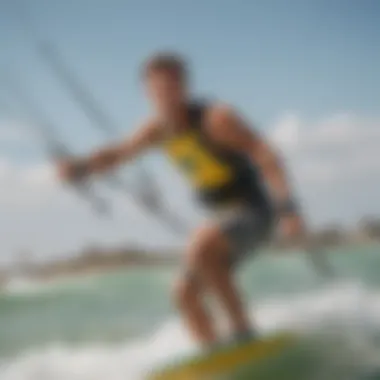
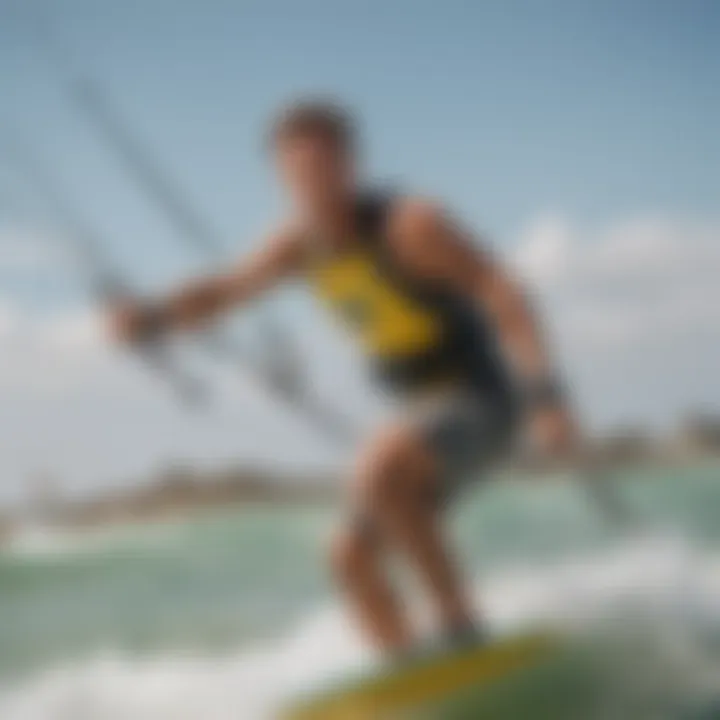
Kiteboarding Equipment Overview
Kiteboarding is not just about the thrill of gliding over the water; it heavily relies on the right equipment to ensure both performance and safety. Understanding the specific elements of kiteboarding gear can make or break a rider’s experience, especially for beginners. Each piece of equipment has been meticulously designed to adapt to various wind conditions and riding styles. Therefore, an overview of the equipment used in kiteboarding highlights the necessity of selecting the appropriate tools for success in this captivating sport.
Types of Kites
Kites are the heart of kiteboarding. Depending on the wind conditions and the skill level of the rider, various types of kites serve different purposes. The selection of a kite can greatly influence the riding experience.
- Leisure Kites: These are typically inflatable kites that offer stability and ease of use, perfect for beginners who are just getting the hang of things.
- C kites: A classic design that delivers a strong pull; ideally suited for experienced riders who want to perform tricks and jumps.
- Hybrid kites: As the name suggests, these combine features from both leisure and C kites. They are versatile and perform well in varied conditions, appealing to a broader audience.
- Foil kites: Unlike their inflatable counterparts, foil kites are more streamlined and lighter, making them suitable for light wind conditions galore. These kites can provide a unique experience for those willing to explore them.
Understanding these categories is vital for trainers to guide new riders toward choosing the right equipment, tailored for specific conditions and user capabilities.
Boards: An In-Depth Look
The kiteboard is the second half of the kiteboarding equation. This portion of the gear impacts how smoothly and efficiently a rider navigates the waves. Boards come in several shapes and sizes:
- Directional Boards: Designed for those who prefer to ride predominantly in one direction. These boards allow for smooth transitions and efficient carving.
- Twin-Tip Boards: Offering ease of use, these boards can be ridden either way, giving riders flexibility when switching directions. Twin-tips are excellent for tricks and jumps alike.
- Race Boards: For the competitive spirit, these boards are tailored for speed and are narrower in design, promising a straight path and enhancing performance in races.
When selecting a board, kiteboard trainers must consider not just the riding style but also the comfort and skill level of their students. Each type has its unique feel and performance standards.
Safety Gear Essentials
Even the most thrilling adventure must be approached with caution, especially in a sport like kiteboarding. Equipping oneself with the correct safety gear is non-negotiable. Here are the key pieces:**
- Harness: The harness connects the rider to the kite, facilitating control. Proper fitting is vital to ensure both comfort and safety.
- Helmet: Protecting the noggin is crucial. A helmet designed specifically for watersports will add safety against unexpected falls or collisions.
- Impact Vest: This provides buoyancy and can absorb impact during high-speed falls, ensuring riders remain protected even in rough waters.
- Safety Leash: Connecting the rider’s harness to the kite ensures immediate disconnection of the kite if control is lost, enhancing safety in critical situations.
- Wetsuit: Not only does it keep the rider warm, but it also adds a layer of protection against abrasive surfaces and sharp objects in the water.
Safety gear can often be overlooked, especially by newcomers with an eye toward excitement rather than protection. A solid trainer should instill the importance of this gear early in the learning process.
It’s not just about having fun; it’s about being prepared for the unexpected.
Emphasizing Safety in Kiteboarding
Ensuring safety in kiteboarding is not just a regulatory hurdle but an essential component that can mean the difference between a thrilling experience and a tragic mishap. Given the nature of the sport, where athletes are often at the mercy of wind and water, safety must always be in the forefront of both trainers and learners. By understanding and prioritizing safety, kiteboard trainers foster a culture that not only protects participants but also enhances overall enjoyment and progression in the sport.
Understanding Wind Conditions
Wind conditions can vary dramatically, impacting every aspect of kiteboarding, from how well the kite flies to how challenging the waters can be. A kiteboard trainer needs to help students recognize these variations. It's important to interpret wind patterns, gauge strengths, and predict gusts.
Here’s what a trainer should emphasize:
- Kite Selection: Different kites respond differently to wind speeds. Standing in front of a choice between a small kite for high winds or a larger one for lighter winds might seem straightforward, but many novices struggle with these decisions. Training should develop an instinct for this crucial selection.
- Sailing Zones: Not all areas are safe for kiteboarding. Understanding where to start and where to avoid is essential. A trainer should guide their students in identifying safe zones and respecting local regulations.
- Weather Awareness: Wind is often influenced by weather systems. Trainers should instill the habit of checking forecasts and recognizing how frontal systems can dramatically alter wind conditions.
By bringing an acute awareness of these points into the training process, students are likely to develop into more independent and aware riders who respect nature's role in the sport.
Emergency Protocols
Even with the best training and precautions, emergencies can occur. Establishing clear protocols is crucial for every kiteboard trainer and their students. Maintaining composure during high-stress situations is equally imperative, and here, a trainer’s role shifts from educator to guide.
Key components to cover include:
- Immediate Actions: If a student gets separated from their board or is in distress, knowing the correct immediate actions can save lives. Trainers should practice and drill emergency retrieval techniques.
- Communication: Establishing a communication system is essential—this includes how to signal for help and how to stay in touch with others on the water either through whistles or visual signals.
- First Aid Essentials: Trainers shouldn't just focus on kiteboarding skills; they should also arm their students with basic first aid knowledge. Knowing fundamental rescue techniques can keep students prepared.
"Preparation is merely the first step towards safe kiteboarding; the second is being aware of failsafe measures and protocols that may need to be enacted in unexpected situations."
Community and Collaboration
The connection between kiteboarding and community cannot be overstated. This niche sport thrives on shared experiences, including the joy of learning and the challenges of mastering skills in a dynamic environment. Kiteboard trainers play a central role in weaving these threads together, ensuring a supportive culture that enhances the overall kiteboarding experience.
Building a Supportive Kiteboarding Community
Creating a robust kiteboarding community involves more than just setting up a few lessons or organizing events. It’s about cultivating relationships that bring together enthusiasts from diverse backgrounds. Trainers often serve as the glue in this community, connecting beginners with seasoned riders, helping to foster an environment where knowledge and skills flow freely.
A supportive community can offer many benefits. First, it facilitates mentorship, where experienced kiteboarders share their wisdom and experiences. This not only accelerates learning but also helps newcomers to avoid common pitfalls. Additionally, training sessions can become social events, creating bonds that extend the camaraderie beyond the beach.
Trainers can implement various strategies to build this community:
- Organizing Regular Meet-ups: Casual gatherings encourage kiteboarders to share tips, experiences, and stories, reinforcing a sense of belonging.
- Creating Online Groups: Using platforms like Facebook or Reddit, trainers can facilitate discussions, share resources, and provide updates about local events or conditions.
- Hosting Workshops and Events: These can range from skill-building sessions to fun contests, pulling in participants of various skill levels.
“A supportive environment in kiteboarding is as pivotal as the wind in the sails; it drives us forward and keeps us upright.”
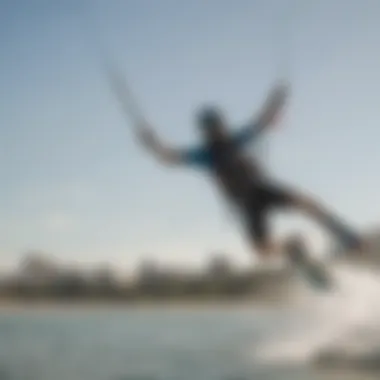
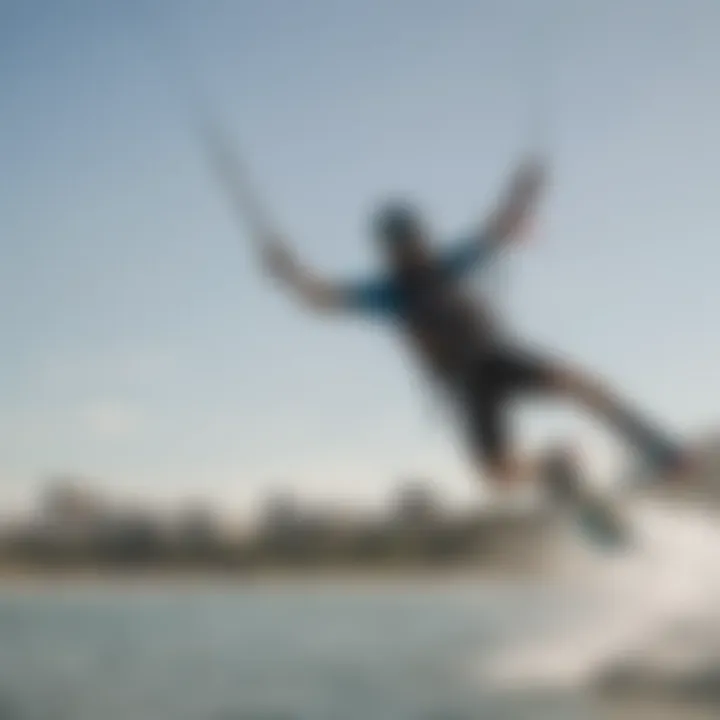
Mentorship Roles in Kiteboarding
Mentorship is a cornerstone of the kiteboarding community, acting as a bridge between novice and experienced kiteboarders. Trainers often step into mentorship roles, providing sustained guidance beyond initial lessons. This relationship can be mutually beneficial; as trainers grow their skills and understanding of the sport, they also gain insights from their mentees’ fresh perspectives and challenges.
In peer-to-peer mentorship contexts, there are a few key considerations:
- Structured Guidance and Support: Newer kiteboarders appreciate tailored advice as they navigate through their learning processes. Trainers can deliver structured guidance, breaking down complex skills into manageable steps.
- Encouraging a Growth Mindset: By fostering resilience and promoting the idea that mistakes are part of the learning curve, trainers help developing kiteboarders gain confidence.
- Creating Networks: A strong mentorship program often results in a tight-knit community, where kiteboarders support one another and share opportunities for growth.
Ultimately, trainers not only teach skills but also contribute to a legacy of learning that can empower the next generation of kiteboarders. This cycle of mentorship strengthens the sport, ensuring that its rich traditions and innovations continue to thrive.
Trends in Kiteboarding Training
As kiteboarding continues to evolve, trainers must stay abreast of the latest trends that impact both instruction and performance. Emphasizing the importance of adapting to these trends is crucial for trainers looking to provide an optimal learning experience. The right trends can enhance safety, streamline processes, and ultimately cultivate a more skilled kiteboarding community.
Emerging Techniques and Tools
Innovative techniques are at the forefront of modern kiteboarding training. Instructors now leverage technology in ways that were once unimaginable. For instance, drone footage is being used to analyze a kiteboarder's posture and movement from an aerial perspective, providing insights that ground-based coaching simply can't achieve. This not only allows for tailored feedback but also boosts the learner’s understanding of their own body mechanics on the board.
Moreover, virtual reality simulations have gained traction. These platforms enable trainees to "experience" kiteboarding in a controlled environment without the risks associated with actual water activities. With the advancement in VR tech, learners can practice techniques before stepping out on the water. Trainers can set up scenarios that highlight particular skills—like executing jumps or handling tricky wind conditions—making the learning curve less steep.
- Use of drones for analysis
- Virtual reality simulations for practice
- Interactive apps to monitor wind conditions and predict optimal diving times
"In the battle for the best learning experience, technology is the knight in shining armor for kiteboard trainers today."
New tools such as inflatable launch pads are making the setup easier. Traditionally, getting beginners comfortable in the water can be a chore, with setup involving heavy gear. These inflatable pads provide a lightweight, accessible way for early learners to focus on balance and kite control, right from the start.
Shifts in Training Demographics
The kiteboarding community is becoming increasingly diverse. This demographic shift is significant for trainers. The sport is no longer just associated with young thrill-seekers. Nowadays, more women and older adults are diving into the watersport. As a trainer, adapting techniques and communication styles to accommodate various age groups and skill levels becomes imperative.
Instructors are also observing more couples and families participating together. This adds another layer of complexity but also an exciting dynamic, as training can be tailored to suit both individual learning styles and group interactions. On one hand, it fosters a collaborative atmosphere; on the other, it necessitates a deep understanding of how different learning speeds affect the group's overall progress.
- Increased participation from women and older adults
- Families getting involved together
- Importance of tailored communication styles
As trainers, recognizing and embracing these shifts allows for a more enriching environment where all can thrive. Being aware of who walks into the training sessions not only helps in customizing the teaching methods but also enhances community spirit among kiteboarders.
In summary, keeping an eye on these trends in kiteboarding training is pivotal for every instructor aiming to excel and provide a comprehensive training experience. With shifts in technology and demographics, the landscape of kiteboarding is broadening, and trainers have a unique opportunity to adapt and flourish.
Evaluating Training Success
Evaluating the success of training in kiteboarding is pivotal, not just for the growth of individual students, but for the overall vitality of the sport itself. By assessing how well trainees progress and internalize essential skills, trainers can tailor their instructional methods to suit learners’ unique needs. This evaluation process serves as a means to recognize strengths and weaknesses in both teaching methods and student capabilities.
A successful kiteboard training session concludes with more than just a few flips or a smooth ride across the water; it encompasses a broader evaluation of the skills acquired, the learning experience shared, and the safety measures maintained. Rather than viewing skill mastery as a binary outcome, evaluating training success showcases it as a journey filled with incremental improvements.
Metrics for Skill Progression
When discussing skill progression in kiteboarding, several quantitative and qualitative metrics can grant insight into a trainee's development. These metrics not only highlight progress but also encourage students to reach for the next level. Some noteworthy measures include:
- Skill Checklists: Trainers can create detailed checklists aligned with each proficiency level. For instance, mastering kite control before advancing to jumps ensures that a foundational skill is firmly in place.
- Video Analysis: Recording sessions allows trainers and students to visually assess performance over time. Reviewing footage can reveal nuanced areas that either exhibit growth or require further refinement.
- Peer Review: Having trainees evaluate each other's performance fosters a collaborative environment. Students often spot each other's techniques and can provide feedback that trainers might miss.
- Self-Reflection Journals: Encouraging students to keep a journal detailing their feelings about each session can yield a wealth of qualitative data. Reflections can expose confidence levels, perceived hurdles, and areas they feel strong in.
Overall, it’s essential to adopt a holistic approach when measuring skill progression that resonates with the nature of kiteboarding and its individual expression.
Feedback Mechanisms
Feedback mechanisms are one of the cornerstones of effective training methodologies in kiteboarding. They lay the groundwork for open communication between trainers and learners and are crucial for maintaining safety and enhancing learning.
Types of Feedback Tools:
- Post-Session Debriefs: After a session, trainers should engage in discussions with students covering the day’s accomplishments and challenges. This creates a reflective space for improvement.
- Surveys and Questionnaires: Regularly distributed forms can help gauge student satisfaction and areas the trainer can focus on. An open-ended question like "What part of today's training did you find most valuable?" can yield insightful responses.
- Performance Review Meetings: Setting aside time every couple of months for one-on-one meetings can help in tracking progression over a longer term, focusing on both successes and aspects needing attention.
Establishing these feedback channels nurtures an environment where students feel supported, enabling personal and technical growth. As kiteboarding evolves, utilizing rich feedback loops will ensure both trainers and students stay on a productive path, contributing to the growth of a thriving kiteboarding community.
Closure
The importance of understanding the role of kiteboard trainers cannot be overstated, especially in the context of the growing popularity of kiteboarding as a thrilling watersport. Trainers are not merely instructors; they hold the keys to unlocking skills that are crucial for safety and enjoyment on the water. Their influence goes beyond individual lessons, shaping the kiteboarding community as a whole.
Future of Kiteboarding Training
As kiteboarding continues to evolve, the field of training is on a similar trajectory of change. Here are some considerations for the future of kiteboarding training:
- Incorporation of Technology: Virtual reality and drone technology promise to introduce new angles to training, helping students visualize maneuvers before hitting the water.
- Diversity in Training: With more women and younger individuals taking up the sport, training methods will need to adapt, fostering inclusivity and addressing unique challenges in a diverse student base.
- Sustainability Focus: Environmental awareness is becoming more crucial. Trainers might emphasize eco-friendly practices, teaching students about minimizing their environmental footprint while enjoying the sport.
- Community Engagement: A strong kiteboarding community can amplify learning, and trainers will play a vital role in building these connections, organizing events, and promoting collaborative learning environments.
"The trainer's influence extends beyond immediate skill acquisition; it cultivates a love for the sport that can last a lifetime."
Ultimately, the future of kiteboarding training hinges on adaptability, creativity, and a commitment to community. As the sport gains traction, trainers will increasingly become the catalysts for its positive growth.















